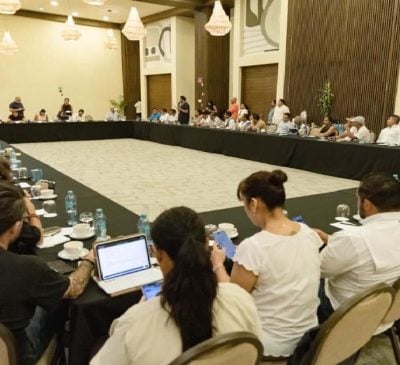Tulum, Q.R. — The Archaeological Zone of Tulum is being digitally conserved as part of a federal government project. Buildings of the Mayan city are being detailed with graphic records.
Patricia Meehan Hermanson, the coordinator of the conservation project, says the project is focusing on more detailed and precise graphic records of the architectural complexes, buildings, wall surfaces and decorative elements on facades and sidewalks, “thus constituting a unique corpus for undertaking future work”.
The orthomosaics and digital surface models, among other drone photogrammetry products, are processed by the architect of the INAH Archaeological Studies Directorate, Emilio Fernández Gamboa, who has trained other team members in the matter.
This will insure restorers will be able to obtain three-dimensional images of elements with specific damage, and have an exact idea of the before and after their intervention.
The specialist from the INAH’s National Coordination for the Conservation of Cultural Heritage (CNCPC) reports that the work plan includes seven buildings, the Temple of the Frescoes, the Castle (the most emblematic of Tulum), the Temple of the Descending God, the House of Halach Uinik, the Palace of Columns, the House of Chultún and the North Tower of the wall.
“Our priorities are mural painting, stucco and flattened reliefs, with or without color, as well as floors and sidewalks. This represents a great opportunity for the project because it provides a more homogeneous level of conservation to Tulum in addition to the systematization of these tasks, something that we had not achieved due to lack of human and financial resources, as well as and time.
She said that “due to the proximity of the site to the Caribbean Sea, the presence of salts in the lime flattening is common, which are preserved due to their great hardness because they have a percentage of magnesium, but also show preferential deterioration in shaped like alveoli, as if it were a Gruyère cheese. Another conservation issue is related to the fauna that inhabits the walls and roofs of buildings, such as iguanas and bats.”
“The objective is to leave the site with an acceptable level of conservation and from there, formulate maintenance plans at different terms,” says Meehan who is accompanied by a dozen restorers, two architects and 12 additional field support people.
Meehan said that the conservation project works hand-in-hand with that of archaeology, in charge of the researcher of the INAH Quintana Roo Center, Antonio Reyes Solís, since the preservation of murals, stuccos and other elements goes hand-in-hand with the structural stability of the buildings.
The conservation project is being carried with financing from the Program for the Improvement of Archaeological Zones (Promeza) through the Ministry of Culture of the Government of Mexico and the National Institute of Anthropology and History (INAH).


